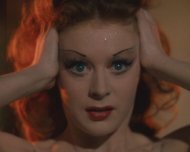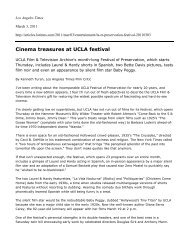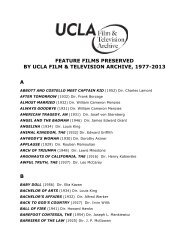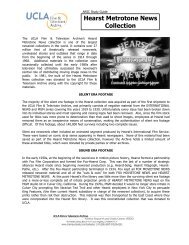"Heroic Grace" catalog - UCLA Film & Television Archive
"Heroic Grace" catalog - UCLA Film & Television Archive
"Heroic Grace" catalog - UCLA Film & Television Archive
You also want an ePaper? Increase the reach of your titles
YUMPU automatically turns print PDFs into web optimized ePapers that Google loves.
courage, cleverness, loyalty, and merciless retribution. Yet not even the<br />
Greeks insisted that every human relationship find its expression in<br />
punches, kicks, dodges, leaps, or thrusts with a weapon.<br />
Cultural historians will point out that this world was precipitated out<br />
of centuries of Chinese culture. From Confucianism comes the respect<br />
of younger for elder, subordinate for sovereign, woman for man, along<br />
with all the obligations which weigh upon the characters. From Buddhism<br />
comes the cultivation of spiritual purity through rigorous disciplining<br />
of the body. From Daoism comes a recognition of the essential mixedness<br />
of all things. From China’s unhappy history comes a bone-deep<br />
suspicion of all rulers but also a faith in the outlaw fighter, who can<br />
bring rough justice to a world pervaded by greed and hypocrisy. And<br />
from Chinese popular culture pours a wealth of written tales and theatrical<br />
traditions which have streamlined, exaggerated and mythified<br />
the national heritage.<br />
Chinese popular cinema is a noisy, vulgar version of these images and<br />
ideas. And no version of that cinema is more extreme than the martial<br />
arts films which came to prominence in Hong Kong after World War II,<br />
especially from the mid-1960s onward. To reap the rewards of that cinema,<br />
the viewer must first accept, or at least tolerate, some of the most<br />
shameless assaults on taste yet contrived by any film industry. We must<br />
take for granted overacting, along with bad teeth, bad skin and bad fake<br />
hair. We have to live with music cues stolen from other movies. (For<br />
some reason the Max Steiner score for the 1933 KING KONG became a<br />
favorite musical fallback at Shaw Brothers in the 1980s.) We must accept<br />
that any movement of arms or swords through air creates a fearsome<br />
whoosh, and that any punch or kick sounds like kindling being split. We<br />
must get used to geysers of blood, hurried decapitations and amputations.<br />
We must not be over-shocked by grotesquerie and deformity, all<br />
treated with a casual callousness that might give pause to Buñuel. Again<br />
we are in a world echoing childhood: playground morality meets our fascination<br />
with the frailties of the flesh. Both exalting and mocking the<br />
body in extremis, Hong Kong presented the most nakedly carnal cinema<br />
the world had yet seen.<br />
The single-minded pursuit of sensation drove this cinema to unique<br />
cinematic accomplishments. At their best, these films have made powerful<br />
contributions to the art and craft of moviemaking. From the 1960s<br />
through the 1980s Hong Kong filmmakers invented a new range of vivid<br />
cinematic forms and carried them off boldly. But to appreciate this cinema<br />
as a “martial art,” we need to adjust our mental framelines.<br />
PLOT AS A CANTONESE MEAL<br />
Although the most ambitious swordplay films of the 1960s often present<br />
fairly complicated tales of quest or military intrigue, the kung fu films of<br />
the next decades offered something more casual and episodic. The Hong<br />
Kong critic Li Cheuk-to compares these later films to Cantonese cuisine:<br />
the cook confidently mixes a variety of ingredients into a single dish,<br />
letting each one retain its identity.<br />
It’s as if directors began to realize that the fights were the film’s<br />
raison d’être (especially for overseas audiences) and that several were<br />
necessary to hold the audience’s interest. Whereas a COME DRINK WITH<br />
ME (DAI ZUI XIA, King Hu, 1966) could hold the audience’s attention with<br />
smoldering intrigue, most filmmakers felt that overt action was the key.<br />
This called for a new approach to plot architecture. First, combat would<br />
need to be arranged on a continuum: Salt several varied fight sequences<br />
through the movie, varying them in intricacy and emotional intensity.<br />
The climactic fight might take as long as 10 or 15 minutes, providing a<br />
10<br />
wholly engaging, if exhausting wrap-up to the action. So now the problem<br />
was: How to motivate more and varied fights?<br />
Well, you could survey a range of fighting tactics. The plot could<br />
bring in fighters adept in varying weaponry or techniques. This allowed<br />
martial arts choreographers, themselves typically aware of alternative<br />
traditions, to freshen up their presentation. The 1970s kung fu films<br />
became repositories of a huge number of (cinematically spruced-up)<br />
combat styles, from southern Chinese Wing Chun (Yong Chun) to Korean<br />
Hapkido. Lau Kar-leung (Liu Jialiang) surveyed the whole vocabulary of<br />
Asian martial arts. A single Lau film can explore one tradition in depth,<br />
as in the “rooftop kung fu” variants on pole-fighting that enliven RETURN<br />
TO THE 36TH CHAMBER (SHAOLIN DAPENG DASHI, 1980). He juxtaposes<br />
Japanese and Chinese styles in SHAOLIN CHALLENGES NINJA (ZHONGHUA<br />
ZHANGFU, 1978), while the climax of LEGENDARY WEAPONS OF CHINA (SHIBA<br />
BAN WUYI, 1982) features a virtuoso display of techniques with swords,<br />
halberds, maces, and other heavy armaments—18 weapons in all! This<br />
all-out assault was borrowed in the final reels of Ang Lee’s CROUCHING<br />
TIGER, HIDDEN DRAGON (WO HU CANG LONG, 2000), when Yu Shulian (Michelle<br />
Yeoh) tries out an array of weaponry against the pilfered Green Destiny<br />
Sword wielded by Jen (Zhang Ziyi).<br />
Introducing a range of styles or weapons could thus fill out the number<br />
of fights; another, not unconnected, tactic was to create a hierarchy<br />
of opponents. Bruce Lee taught kung fu filmmakers the need for a range<br />
of villains to pad out the plot. Otherwise our invincible hero would<br />
advance straight to the big boss, wipe him out, and the movie would be<br />
over. So while the hero often has several allies, some of whom will be<br />
conveniently killed, the main opponent may also have a posse of subordinates,<br />
trained in a variety of styles. The protagonist will often have to<br />
work his or her way up the chain of command, dealing with each figure in<br />
turn. Of course one could also multiply heroes, a strategy to which both<br />
King Hu and Zhang Che (Chang Cheh) were drawn. With every new protagonist<br />
came the display of new fighting skills and one-off encounters with<br />
villains. Hu’s fighting brigade in DRAGON INN (LONGMEN KEZHAN, 1968) represented<br />
a complementary balance of skills and shortcomings; here even<br />
sets and costumes seem designed to highlight complementary and conflicting<br />
aspects of each skirmish. Zhang was fascinated by bonded pairs<br />
of heroes, but he expanded the cast to include three in BLOOD BROTHERS<br />
(CI MA, 1973): As the friendship among his fighters is corroded by ambition,<br />
adultery, and revenge, the plot encourages a range of thrilling<br />
fights. Zhang carried this ruthless multiplication even further in his<br />
ensemble-based FIVE VENOMS (WU DU) films.<br />
Even if the plot sticks with a single protagonist, he or she may still be<br />
unfinished—a youngster with promising talent but lacking in skill. The<br />
apprentice plot which results allows for a variety of combat sequences,<br />
particularly between masters and bullies, and montages of training sessions<br />
can keep the action moving. An early prototype was Zhang’s ONE-<br />
ARMED SWORDSMAN (DUBI DAO, 1967), in which the maimed hero must<br />
agonizingly retrain himself. THE 36TH CHAMBER OF SHAOLIN (SHAOLIN SAN-<br />
SHILIU FANG, 1978) makes grueling training central to the plot, while the<br />
last third of Sammo Hung’s THE PRODIGAL SON (BAI GA CHAI/BAIJIA ZAI,<br />
1981) plays out a slapstick variant of the apprentice plot, with the young<br />
hero (Yuan Biao) hampered by an arm-cast and the rivalry of two Wing<br />
Chun masters.<br />
More generally, the milieu of a martial-arts school permits many plot<br />
expansions. If the action revolves around the Confucian hierarchy of a<br />
school, with its echelons of masters and disciples, the conflict may<br />
spring from jealousy and mistrust among students, as in ONE-ARMED<br />
SWORDSMAN. The school also yields the hierarchy of villainy and range of

















